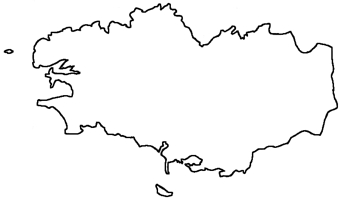
|
The Society of Folk Dance Historians (SFDH) Brittany
[
Home |
About |
Encyclopedia | CLICK IMAGE TO ENLARGE |

|
BACKGROUND
Information: A region. The people of Brittany are "Bretons."
Brittany is a cultural region in the northwest of France, covering the western part of what was known as Armorica during the period of Roman occupation. It became an independent kingdom and then a duchy before being united with the Kingdom of France in 1532 as a province. It is bordered by the English Channel to the north, the Celtic Sea and the Atlantic Ocean to the west, and the Bay of Biscay to the south.
Brittany has a vibrant calendar of festivals and events. It hosts some of France's biggest contemporary music festivals, such as La Route du Rock in Saint-Malo, the Vieilles Charrues in Carhaix, the Rencontres Trans Musicales in Rennes, the Festival du Bout du Monde in Crozon, the Hellfest in Clisson and the Astropolis in Brest. The Festival Interceltique de Lorient welcomes each year participants all the Celtic nations and their diasporas. La Folle Journée, in Nantes, is the largest classical music festival in France.
Brittany's ties with Nazism and the collaborationism of the Breton National Party during World War II weakened Breton nationalism in the post-war period. Brittany lost 240,000 men during the First World War. The Second World War was also catastrophic for the region as it was invaded by Nazi Germany in 1940.
Breton dances usually imply circles, chains or couples and they are different in every region. The oldest dances seem to be the Passepied and the Gavotte, and the newest ones derive from the Quadrille and French Renaissance dances.
Most Polpular Dance: Jibidi-Jibidao
Location: Europe
Languages: Breton and Gallo
Religions: Predominantly Christian
DOCUMENTS
- An Dro, a dance.
- Avant-Deux, a dance.
- Bannielou Lambaol, a dance.
- Le Bal de Jugon, a dance.
- Breton Folk Dance, an article.
Printed in Folk Dance Scene, September 1978.
This page © 2018 by Ron Houston.
Please do not copy any part of this page without including this copyright notice.
Please do not copy small portions out of context.
Please do not copy large portions without permission from Ron Houston.